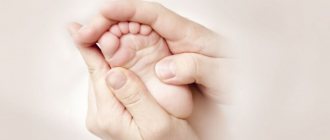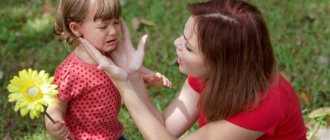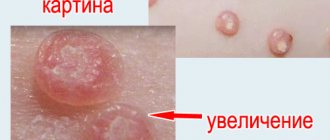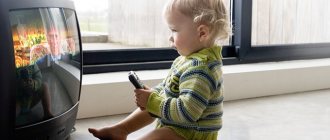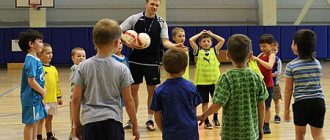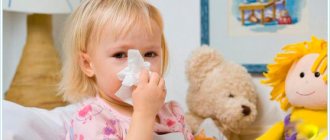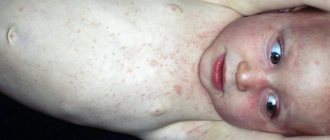Experts consider valgus flatfoot to be the most common pathology among children's orthopedic diseases. Most often, hallux valgus in children is diagnosed as soon as the child takes his first steps. This disease is characterized by the incorrect positioning of the baby’s feet relative to each other; when walking, the emphasis is on their inner side.
A congenital disease can be determined during the first examination of a child by an orthopedist, still in the maternity hospital. Young children have a small layer of fat on their feet, so at this age the pathology of foot development is also not visible. You can speak confidently about the presence or absence of such a pathology when the child’s skeleton is fully formed, by about 6 years of age.
Causes
It is quite difficult to determine hallux valgus in children under two years of age from photographs. Experts consider deviations of this kind to be the norm at this age. It is also necessary to take into account the similarity of this disease with clubfoot.
The reasons for its occurrence may be identical to flat feet, but the treatment will require a completely different one.
The main factor in the appearance of valgus flatfoot in a child is considered to be heredity.
If one of the parents suffered from such a disease, then it is highly likely that it will appear in his children.
Flat valgus deformity of the feet can also develop for the following reasons:
- Maternal overweight and severe obesity during pregnancy;
- Wearing uncomfortable shoes;
- Joint hypermobility;
- Foot injuries;
- Impaired motor functions;
- Endocrine diseases;
- Violation of calcium metabolism, as well as other useful substances in the body;
- Lack of vitamin D;
- The presence of cerebral palsy, polio and other diseases that cause paralysis of the lower extremities.
Prevention measures
If the baby is not diagnosed with a congenital pathology, then such a disease can be prevented with the help of preventive measures.
Orthopedists advise:
- Do not place the child on his legs until his musculoskeletal system has become stronger.
Babies should stand up on their own after about 9 to 10 months.
Buy the right shoes that:
- matches the length of the foot;
- fixes the heel;
- has an orthopedic insole;
- breathable.
The child should take his first steps in light, comfortable and properly selected shoes.
- Do simple gymnastic exercises with your baby every day, for example, walking on an orthopedic carpet barefoot or moving small objects with your toes.
- Choose the right diet for your child so that all useful elements enter the body in the proper amount.
- Walk every day.
- Go swimming.
- Encourage your child to be physically active.
It is also important to regularly visit the pediatrician, and if you suspect any defects, start treatment on time.
Let's celebrate! Hallux valgus is observed in many children, and in the vast majority it can be successfully treated, especially in the first stages.
The child’s parents need to carefully monitor the development of the baby, undergo routine medical examinations with him in a timely manner, and if a pathology is detected, immediately begin the prescribed treatment.
Blitz - tips:
- Do not try to massage your baby’s deformed feet yourself;
- do not carry out therapeutic exercises without the supervision of a specialist;
- Make sure that the child walks only in special orthopedic shoes.
Types of pathology
The appearance of a flat valgus foot in a child can be a congenital or acquired disease. In the first case, the foot can become deformed in the womb along with the formation of the child’s skeleton.
The acquired form of the disease is the result of the negative influence of one or more negative factors on the body. The nature of the hallux valgus deformity in a child can be different.
There are three following types of hallux valgus pathology:
- Transverse. The main signs of this pathology include a noticeably enlarged forefoot. The muscles and tendons responsible for extending the fingers are tense. The child complains of nagging pain.
- Longitudinal. This pathology can be determined by a disturbance in gait, a change in the shape of the foot, when palpated, the baby feels severe pain. The child cannot stand on his feet for a long time, as the incorrect position of the feet causes discomfort.
- Combined. This type of flatfoot has all the signs of the disease, but they are rarely accompanied by pain. Combined foot deformity does not cause any discomfort to the child.
Below you can see photographs of hallux valgus in children:
Gymnastics for flat feet
- Rolling a stick or ball with your foot.
- Grabbing a pencil or rag from the floor using your toes.
- Alternating walking on toes and on heels: 4 steps on toes, 4 steps on heels. Walk like this until your legs get tired. Given the obvious ease of performing this exercise, you can pick up dumbbells.
- Walking on the outer surface of the foot.
- Walking on toes.
- Flexion and extension of the toes.
- Raising the body on the calf muscle: place a block 30-40 mm high on the floor, stand with one leg with the toe of the foot on the block and lift until tired, the other leg does not participate in the movement. If the exercise is obviously easy to perform, take dumbbells in your hand. Take dumbbells from the side of the loaded leg.
- For the especially lazy, you can suggest the following exercise: When climbing stairs, try to climb on your toes (stand on the step with your toe, not your full foot), loading your calf muscles and foot muscles. Having climbed to the third floor, you will already feel tired in your feet and calf muscles.
- It is very useful to walk barefoot on uneven surfaces, such as dirt or grass outside the city. Please note that villagers practically do not suffer from flat feet, because... the muscles of the foot are loaded in a variety of ways, and in the city we walk exclusively on a flat surface and the foot is loaded exclusively in one direction.
Degrees of development
Valgus flatfoot can have four degrees of development. Each form of the disease is characterized by a special course of the disease. Methods of diagnosis and treatment will also be different in each case.
Valgus position of the leg develops in stages:
Stage 1. The initial stage of the disease is quite easily and quickly diagnosed and treated. The foot at the first stage of valgus flatfoot is located flat, with a slight deviation (15°.)
Stage 2. At this stage, there is a 20° deviation of the foot. Treatment of the disease will be lengthy, but with maximum effort and resorting to various techniques, a complete recovery is possible.
Stage 3. It will be quite difficult to eliminate foot deformation with a deviation of up to 30°. Therapy must be comprehensive using massage, traditional methods of treatment, and long-term wearing of orthopedic shoes will also be necessary.
Stage 4. This form of hallux valgus is the most severe. With stage 4 flatfoot, the child’s foot is flat and the deviation angle exceeds 30°.
Complex treatment in this case is unlikely to show a positive result. The only option for getting rid of foot deformity is surgery.
Treatment methods
It is well known that advanced cases of flat feet often lead to deep health problems and even lead to disability. In addition, flat feet create some restrictions in choosing a profession. Due to the fact that the foot plays an extremely important role when standing, walking, running, jumping, people with flat feet are not suitable for professions related to these movements. Examples of such professions include hairdresser, salesman, waiter, operative, military, surgeon... All experts are unanimous: treating flat feet is a more difficult task than preventing it. However, many children suffer from this disease precisely because preventive and treatment measures were not taken in time. This is why early consultation with a doctor and preventive examinations by a pediatric orthopedist are very important.
To prevent flat feet, wearing properly fitted shoes is very important. Do not allow another child to wear used shoes. The inner edge of the shoe should be straight so that the first toe does not move inward, the heel is no more than 1-2 cm for children under 2 years old, no more than 3-4 cm from 3 years old. Great importance is attached to wearing orthopedic insoles, both serial, in mild cases of flat feet, and individually made, in severe deformities. When using arch supports, it is recommended not to wear them continuously. On the first day, wear the instep supports for no more than one hour; on the second and all subsequent days, increase the adaptation period by half an hour. Shoes should be spacious and deep enough. Remember that shoes that are too narrow, tight, or hard can reduce or negate the effect of orthopedic arch supports and even cause damage to the foot.
Do not rush your baby to get to his feet and take his first steps, he himself must be ready for this important stage, limit prolonged standing of babies. Treatment of flat feet is complex, the important components of which are physical exercises, exercise therapy, hardening, motor and hygienic regimes. In prevention, regularity, the right choice of shoes are important, walking barefoot on uneven surfaces, skiing, and swimming are useful.
There are a huge number of physical exercises aimed at treating flat feet. For the effectiveness of classes, the interest of children in performing this set of exercises is important. But how to interest a child? After all, performing exercises that are perfectly matched to each other often, due to age characteristics, bores the child. And this, naturally, affects the quality of the exercises and inevitably leads to a decrease in the effectiveness of treatment. Turn gymnastics into a game. Story-based games and activities help to satisfy children's creative imagination. Create games with elements of mystery, surprise, hiding and guessing.
To prevent flat feet, special physical exercises for the feet are useful. They develop the ligamentous apparatus of the foot. Massage is also helpful. In this case, there is no need to run to a massage therapist. For this purpose, you can use regular ledgers and similar roller tracks, hedgehog balls, roller sticks, mats with rubber spikes, boxes of beans or expanded clay, etc.
Symptoms
Curvature of the foot valgus does not occur suddenly, but develops over a fairly long period, so the chances of recovery are quite high. Successful treatment of valgus flatfoot depends on timely, accurate diagnosis. The sooner parents notice sole deformation in their baby, the easier and faster the therapy will be. The following symptoms should be the reason to visit an orthopedist:
- The child complains at the end of the day of nagging pain in the legs;
- Unsteady gait, waddling from side to side;
- The presence of calluses and corns on the soles;
- The fingers are constantly spread apart rather than clenched together;
- The child complains about uncomfortable shoes due to the width and other features of the sole.
What it is?
Foot deformation refers to certain deviations from the norm in its development. This pathology can be inherited, or it can be acquired. Fortunately, it is not a life-threatening condition, and sometimes it is even curable until complete recovery of the foot. The deformity can develop in the mother in utero, but don’t be alarmed, the mother has absolutely nothing to do with this and cannot in any way affect the proper development of the foot during pregnancy. Basically, the pathology develops when the toddler begins to walk.
It is also important to know that with any pathology complications can develop that are much worse to treat and affect the child’s health. Do not think that this disease is typical only for young children. Remember that your child does not grow and develop for 5 years. And the musculoskeletal system is able to grow and develop up to 25 years.
It is necessary to monitor, observe how quickly the child grows, examine him for the presence of deformities in the joints, especially the arms and legs. Often, any change is perceived as flat feet or club feet, and is later even considered as a pathology.
Therapy methods
Hallux valgus deformity must be treated using several methods. Only with such an integrated approach can one hope for a good result. Absolutely all therapeutic methods are aimed at normalizing the shape of the foot and getting rid of unpleasant symptoms.
The most effective and affordable methods of treating valgus flatfoot are: massage, physical exercise, and wearing specially made shoes. Electrophoresis, wax wraps, acupuncture and foot baths are also often used.
Massage
https://youtu.be/uVyWTOCcaKY
This method of treating valgus flatfoot in children is quite effective. Sessions are carried out in conjunction with other procedures that strengthen the body. In addition to foot massage, attention should be paid to the lower back, since this is where the nerve endings branch off and go to the leg muscles.
To perform a massage with hallux valgus, it is necessary to place the patient on his stomach and place a special cushion under the feet. Using a tong-shaped grip, the sole should be rubbed and kneaded well, massaging rhythmically.
Therapeutic foot massage for flat valgus disease perfectly stabilizes muscle tone, relieves tension, and strengthens muscle tissue.
Also, thanks to the massage, blood supply improves, tissues and ligaments are enriched with oxygen, which normalizes the development of the legs.
The procedure will be more effective if massage for hallux valgus in children and other types of flat feet is supplemented with the following specially designed exercises:
- Capturing and holding a ball or toy with the sole;
- Flexion and extension of the sole;
- Moving fingers;
- Capturing and holding a ball or toy with the sole;
- Shin rotation.
It is always worth remembering that massage for flat valgus feet is the simplest option for basic treatment.
Physiotherapy
Carrying out therapeutic and gymnastic procedures is a mandatory measure in the treatment of valgus flat feet. Exercises should be performed barefoot or wearing thin socks. A set of such measures is aimed at getting the foot used to being in the correct position, especially when walking.
When taking the first steps, the child, to increase his support area, places his feet very wide. Until the age of three, such a gait is considered normal, and later on, correct and stable foot placement is developed.
Experts consider walking along a kind of narrow path to be the best exercise for hallux valgus, aimed at developing correct walking skills. Its width should not exceed 15 centimeters.
You can use a long board, a pattern on the carpet, or simply draw two parallel lines with chalk on the floor. The child must be asked to walk the entire path without stepping outside the aisles of the path.
Children with valgus foot disease are advised to exercise on the wall bars, as well as swimming. Carrying out water procedures has a beneficial effect on the child’s entire body, improves metabolism, and increases immunity.
Jumping on a corrugated orthopedic mat placed in the bathroom will also have a positive effect. Children enjoy doing gymnastics while swimming on a special surface, since the exercises become easy to perform, since the water removes excess stress and the leg moves freely.
Orthopedic shoes
Boots and sandals for a child with hallux valgus, and not only flat feet, should be selected more than thoroughly. They must be made of sufficiently rigid material to hold the foot and heel in the correct horizontal position.
Experts recommend choosing orthopedic high boots for constant wear that completely fix the entire ankle joint.
The size of orthopedic shoes should be selected based on the length of the child’s foot. The sole should be slightly (1 cm) longer than the leg itself. A small wide heel is also required.
Children with the congenital pathology of hallux valgus are strictly prohibited from wearing soft, flat-soled shoes without backs (flip-flops, felt boots, rubber boots, etc.). It is also not recommended to wear someone else's shoes, as this will only cause harm to fragile children's feet.
Children's foot and its development: nothing will come of it without natural training
It has long been said:
Feet are the foundation of our body
Day after day, our feet perform feats, although we are not fully aware of this. The feet support the weight of the body and give us the ability to run, jump, gallop and maintain balance. Together with us, they take 5 million steps every year, and during our lives we walk around the entire globe four times. To do all this without any problems, having well-trained feet is the alpha and omega. Despite the fact that 98% of newborns are born with healthy feet, about 60% of adults have problems with them. And already at school age such developmental deviations as valgus, dropped and hollow feet are observed. After all, if the foundation is no longer adequate, it has consequences for the entire body. This can cause problems with your knees, hips or spine.
Throughout development from cute, little baby feet to adult feet, a number of factors can significantly interfere with their healthy development. One of the main causes of acquired foot injuries is wearing the “wrong” children’s shoes – too small, too narrow, sometimes even too big. The next problem with an increasing trend is excess weight. It promotes flattening and thereby deformation of the arch of the foot. Meanwhile, 15 to 20 percent of children in Germany are overweight, and 6% are even obese (= morbidly obese).
For children's feet to develop healthy, they first need movement. However, all signs point to the opposite. Due to our modern lifestyle, about 14% of children currently move at most 3 hours a week.
To ensure that the problems of excess weight, lack of exercise and proper footwear (only 20% of German citizens wear shoes that fit them) do not continue into adulthood, countermeasures must be taken in a timely manner through education. At the same time, you are asked questions as a foot professional. You have the difficult task of awakening in parents, as well as in children, attention and sensitivity to the care and preservation of feet in a healthy condition.
Children's foot and its development:
Nothing will work without natural training.
Flat feet in a baby, valgus flat feet in a small child, first O-shaped, then X-shaped legs, while soft, flexible, deformable and fairly insensitive to pain when pressure is applied, children's feet are not the small feet of adults. For many years, they were not at all willing to conform to our idea of a “normal” foot.
For parents, the question of whether their children develop healthy feet is of great importance. After all, our feet give us the freedom to walk and move forward independently throughout our lives. Children's feet continually change as they grow. The development of the feet ends only in adolescence.
When a child takes his first steps completely independently, parents are proud of it and remember this date for life. If a small child between the ages of one and a half years is able to walk independently, he has completed intensive training for several months.
Step by step to walking
Twirling (= circular movements of the body while lying on the stomach), rolling, crawling on the stomach, later crawling on all fours, then gradually learning to stand and try to walk - all this serves to train the muscles and musculoskeletal system, as well as the ability to maintain balance and coordination. Even before a child can stand, the legs and feet are prepared for this. So a six-month-old child grabs his feet and fingers and plays with them. If he puts his toes in his mouth while doing this, it's more than just a fun time. The movement is a great exercise to use external rotation, leg abduction, and hip flexion to help develop the hip joint as a mobile joint.
Learning to walk is a genetic program that occurs on its own and is more successful when adults who are “experienced in walking” interfere less with this process. The motto is: wait until the child begins to stand and walk on his own. Children begin their first attempts to stand, pulling themselves up by objects, for example, the bars of a crib or leaning on a landing, at the age of 10 months. They can walk freely after 4-6 months. By this time, the child is exploring various options to support walking, such as leaning sideways on objects (so-called walking with handrails) or pushing objects in front of him to prepare his feet to support body weight. Finally he stands, although at first hesitantly and with his legs wide apart, and is ready to take his first steps.
Playing with your feet and fingers also trains your foot muscles. When a child grabs his feet with his hands, the inner edge of the foot is slightly raised, and it is brought into a supination position (supination through rotation). As a result, both the functional length, width and height of the foot, as well as the entire arch of the foot, are trained.
Children's feet grow quickly
It takes approximately 16 years for children's soft, cartilaginous feet to develop into fully developed feet. Moreover, 98% of feet in girls aged 12-13 years and 98% of feet in boys aged 15 years reach their final length.
Children's feet grow especially rapidly in the first years of life. If the length of the feet of newborns is about 1/3 of the length of the foot of an adult, then the length of the feet of three-year-old children is already 2/3 of their final length.
How children's feet grow differently depending on age was reflected in the first German report on children's feet, for which 20,000 children's feet were measured in 60 locations in Germany and Switzerland: “In 2-year-old children, feet can grow up to two feet. centimeters per year, i.e. That's almost three shoe sizes. In both boys and girls, up to the age of 7, feet grow by 10-15 millimeters per year. Then the growth rate in girls drops to 10 millimeters, and in boys to 8-9 millimeters. After this, the growth rate in girls quickly decreases until the age of 12, and in boys, on the contrary, only from the age of 15.” Thus, it is quite natural that school-age children need new shoes every six months, and young children even once a quarter.
Do not interfere with natural development!
To ensure that children's feet develop healthy and free from any damage, it is important that children are able to fully develop their natural need for movement. Therefore, advise parents to pay special attention to the following.
Children's feet require great freedom of movement. Therefore, parents should allow young children to be barefoot and play with their feet and toes as often as possible. This is not only fun, but also very useful for motor and mental development. And when children can already walk, the rule should be to walk barefoot as much as possible.
Because In the first years of life, children's feet are still developing and are quite flexible; in no case should they be constrained or harmed not only by incorrect shoes, but also by too narrow sliders and socks.
In order not to interfere with natural movement, parents should wait a little while “sitting” their children until the child sits down on his own and can change this position on his own. On average, by the age of 9 to 10 months, children can already do this independently.
It is imperative to caution against forcing your child to get up too early. Therefore, it is recommended not to offer children pull-ups or to hold the child in a standing position for too long. Because small O-shaped legs are unable to support body weight.
The widespread practice of placing 6-month-old children in so-called walkers is extremely controversial. This is the name given to a plastic frame on casters with a built-in seat. The Federal Registered Society "Better Safety for Children" warns against the use of such devices due to the attendant risk of accidents, which often result in serious injury. And at the same time, children do not learn to walk; on the contrary, the more often they are seated in such devices to roll around the apartment, the more noticeably their natural motor development is disrupted, which interferes with the training of natural stepping movements.
It is also necessary to place the baby in a bowl-shaped crib or cradle as little as possible. A predetermined sitting position limits the child's motor capabilities while awake and, thus, the natural development of movement. For example, in a lying position in a cradle, the legs cannot bend at the hip and knee joints, do not rotate outward and do not abduct. It is also impossible for a child to put their feet in their mouth, which is important for training their muscles and their awareness, i.e. lack of training and muscle strengthening.
Flat feet first
It is completely normal for babies and young children to have flat feet and O-shaped legs, which can cause significant problems in adulthood. Typical foot placement in an infant is hip and knee flexion, O-shaped legs, and supination of the feet. The soles of the feet are flat. On the one hand, this is explained by the thick medial fat pad, which extends from the joint of the talus and navicular bones all the way to the metatarsophalangeal joints. Its job is to protect the soft, cartilaginous structures of the feet from overload and damage, and it serves as a pressure distributor. The fat pad decreases during the first years of life and disappears at the age of 4-5 years.
On the other hand, the arch of the foot, the development of which has already begun at birth, is formed gradually with an ever-increasing load on the foot. Only at 3 years of age does the usually visible medial depression begin to be recognized in the foot print.
Digression: The medial pad of the small feet is also called the “acute fat pad.”
With the ability to walk, the foot undergoes a three-dimensional change in shape from the inside. This includes straightening the hindfoot as well as twisting the foot, i.e. change from supination of the foot in infancy to internal rotation of the forefoot. This spiral twist, in which the heel rotates outward and the forefoot inward, is the alpha and omega of arch stabilization.
The “Children's Foot Study” carried out at the University Hospital of Münster, which observed the development of the child's foot in healthy children from the moment they learned to walk until the age of nine, showed that the longitudinal arch of the foot is formed already in the first year after the child learned to walk . The formation of the longitudinal arch of the foot ends, however, only at the age of 6-7 years.
Digression: During the third year of life, the feet change their shape.
From O-shaped legs to straight legs
The position of the baby's feet is reminiscent of our ancestors in ancient times. The hips and knees are flexed, the kneecaps are externally rotated, and the distance between the inside of the knees is greater than between the medial ankles. During the second year of life, curved O-shaped legs become straight, which then most often change into X-shaped legs in children 2-4 years old.
The reason for this is body weight and upright posture, due to which the knee is loaded in the medial direction with increasing pressure, and in the lateral direction with increasing traction. The consequence of this asymmetrical load is an asymmetrical growth stimulus on the bone growth zones (metaphysis) of the femur and tibia (tibia) close to the knee joint. As a result, the epiphyseal cartilages on the hinges of the knee joint of the femur (femoral condyles) and on the areas of the knee joints of the tibia (tibial condyles) grow in length differently quickly - on the inner side (medial) faster than on the outer side (lateral). The load line, as the line of connection between the hip and foot is called, moves towards the middle of the knee joint until finally the hip, knee and foot are vertical on top of each other and the leg is straightened.
In an overreaction, however, growth in length continues on the inner side with the effect that the line of stress is shifted from the middle of the knee joint outward and ultimately passes on the outside of the joint. Thus, from the O-shaped legs of a baby, the X-shaped legs of small children are obtained, in which the knees touch the inside, but the medial ankles do not. In severe forms, the distance from each other can be more than 7 centimeters. With normal development, the X-shaped position of the legs disappears before school age (approximately seven years), and the legs grow straight. The medial ankles and inner sides of the knees touch in a standing position. True, a risk factor for the persistence of the X-shaped legs is excess weight, which many children currently suffer from.
Age-related deformities
The X-shaped position of the legs also affects the position of the feet in young children, because the heel bone bends inward. Valgus flat feet in most cases are caused by age and should disappear, like the X-shaped position of the legs, before school age.
The next observation from the already mentioned study of the children's foot was that the cavus can definitely be an age-related phase of the development of the child's foot. In a group of 45 children who were observed for more than 6.5 years, in 13% of children, the contact area of the metatarsus decreased continuously during the first five years after learning to walk, and then increased again over the next two years, so that the hollow foot was no longer distinguishable.
Variety of feet
The development of a healthy child's foot is amazing and has unexpected variety. Thus, a study of children's feet in the city of Münster showed that in the first year when the child walked, girls showed a more dynamic process of foot roll than boys. According to the first German report on children's feet, children aged 6 years can still wear size 25 shoes, but can also wear size 35 shoes. Compared to girls, boys of the same age, on average, need shoes that are half a size or even a size larger. After 12 years of age the difference increases. The growth curve of girls' feet flattens out, while boys' feet continue to increase. However, the report on children's feet indicates that there is also wide variation in sole width or girth in tufts for the same foot length. For example, in 5-year-old boys, whose average foot length is 172 millimeters, its width can be from 62 to 78 millimeters. (The average width is 70 millimeters.)
The girth in the bundles averages 173.5 millimeters. A foot with a length of 172 millimeters can have a girth from 157 to 190 millimeters. The same report also shows that children's feet have become wider.
Body weight as a cause plays a role only in preschool children. The older the children, the less body weight affects the width of the feet. The exception, however, is overweight children! But it is still true that small feet are wider than large ones. Additionally, it is important for anyone dealing with children's feet to know that children's feet are constantly growing. They don't pause and then jump up 3 or 4 shoe sizes.
From the beginning of school age until the end of the first decade of life, the feet are improved with the goal of free interaction of all tissues and organs, including muscles, ligaments and blood vessels.
Feet and legs of babies and small children...
... do not yet have their final form; and even the skeleton of the foot still consists predominantly of cartilaginous parts, which finally ossify only in adolescence.
Typical for infants' feet is an inward deviation of the big toe.
The longitudinal arch of the foot is filled with a fat pad, and the foot rests flat on the floor.
In the second year of life, the fat pad is absorbed, and the longitudinal arch of the foot is formed gradually.
If the foot is weight-bearing, a slight outward position is quite normal. In a small child, the hallux valgus is more pronounced.
The typical O-shaped position of the legs of a small child. At about 6 years of age, the axis of the legs slowly straightens.
Types of deformations
In orthopedics, there are many developmental anomalies and deformities of the feet, but, fortunately, many types are extremely rare. Therefore, we will consider the most common types.
Children mainly develop two types of foot deformities:
- valgus – X-shaped;
- varus - O-shaped.
Hallux valgus is an X-shaped curvature of the legs. It looks like this - with straightened and compressed knees, the distance between the inner surfaces between the ankles is more than 5 centimeters. The feet seem to be turned outward. This can be either a congenital or acquired pathology. The cause of the congenital one lies in the disruption of the embryonic development of the bones of the feet, and the acquired one lies in the improper development of the muscular and ligamentous apparatus in the period after birth.
Diagnostics
It is not so difficult for parents to determine this pathology on their own. The simplest and most accessible method for them will be a routine inspection. If the child is a newborn, place him on a flat, hard surface, straighten his legs so that they touch at the knee joints and examine. Normally, your legs should be straight and touching each other at the ankles and knees.
Usually, due to their love for the child, parents do not attach importance to even a slight curvature, so listen if one of your relatives or friends says that your child has crooked legs, do not treat this information critically, but as a need to address to a specialist.
To begin with, you can tell your pediatrician about this disease, who will also conduct an examination. He may refer your baby to an orthopedist. An orthopedist is a specialist who treats impaired functions of the musculoskeletal system.
Most likely, the following studies will be ordered:
- X-ray examination of the legs in frontal and lateral projections;
- computer plantography, this study evaluates the condition of the foot structure;
- podometry – assesses the load on different parts of the foot;
- Ultrasound examination of the foot joints.
Treatment
It is important to know that treatment should begin immediately when the disease is identified, and not delay, as it may later become an incorrigible pathology. For hallux valgus, the following procedures are prescribed without surgical intervention:
- warm foot baths;
- massage of legs and feet;
- magnetic therapy;
- mud therapy;
- diadynamic therapy;
- physiotherapy;
- orthopedic shoes.
If the doctor believes that the case is more advanced, he may prescribe plaster casts. This method is aimed at long-term correction and the huge disadvantage of parents is their intolerance, since they, noticing small improvements, remove the plaster cast themselves, not wanting to contact an experienced orthopedist again. This method is mainly used for congenital pathology in newborns.
If physiotherapeutic methods do not provide any improvement, surgical treatment is prescribed. After a more detailed and thorough study of the child’s foot deformity, surgical intervention is performed.
For varus deformity, similar physiotherapy methods are used:
- massage of the lumbar, buttock, thigh, legs and feet;
- calcium electrophoresis;
- physical therapy, which is aimed at correcting the foot, as well as exercises to strengthen the muscular system of the legs;
- orthopedic shoes with special insoles.
This treatment is very simple, but effective enough to ensure complete recovery in childhood, since it is not only useless for adults, but can also cause harm and aggravate the pathological process, which will inevitably be followed by surgery. Tendon-muscular surgery is a traumatic surgical intervention that is contraindicated in young children due to subsequent relapse of the disease.
If the result of conservative physiotherapeutic treatment is negative, parents will be offered surgical treatment. If you still decide that your baby’s changes are minor and do not seek help from an orthopedist, use the knowledge gained from the article and carry out the treatment yourself. After all, it’s not at all difficult to give a massage to a child or heat water for foot baths.


